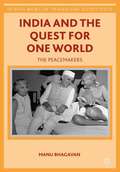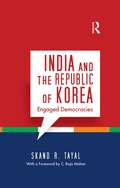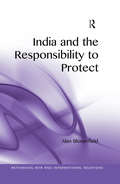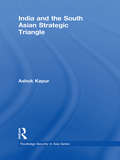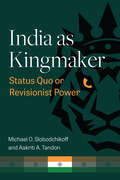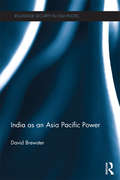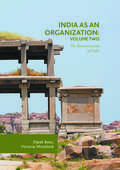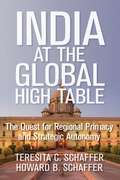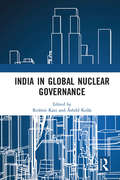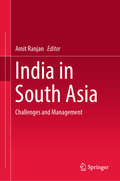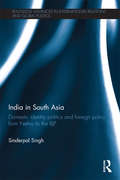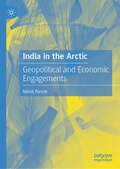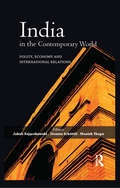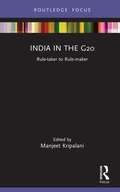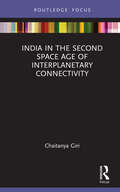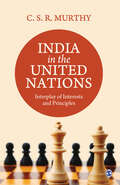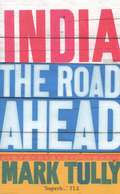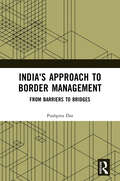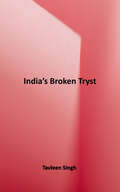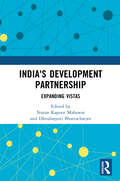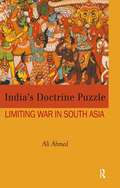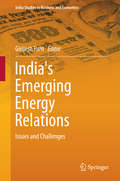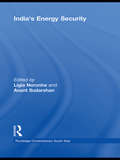- Table View
- List View
India and the Quest for One World
by Manu BhagavanIndia and the Quest for One World revolutionizes the history of human rights, with dramatic impact on some of the most contentious debates of our time, by capturing the exceptional efforts of Mahatma Gandhi and the Nehrus to counter the divisions of the Cold War with an uplifting new vision of justice built on the principle of "unity in diversity. "
India and the Republic of Korea: Engaged Democracies
by Skand R. TayalExamining the underlying logic of the strategic and economic partnership between the Republic of Korea and India, this book is the first detailed study of the numerous facets — cultural, economic, people-to-people, and strategic — of blossoming relations between two major Asian democracies. This comprehensive survey documents the interaction between the two governments, relying on facts and hitherto unpublished original records provided by India’s Ministry of External Affairs; offers an illuminating account of India’s active role as a neutral party in the post-Second World War events of the Korean War and the division of the Korean Peninsula; and provides a vision of the future direction of India–Korea relations. The author also shares candid observations of Korean society and its people during his service as Ambassador of India in Seoul. The work will be useful to policy makers as well as students of politics and international relations, strategic studies, economics, and contemporary world history.
India and the Responsibility to Protect: Negotiating Democratic Postcolonial And Great Power Identities (Rethinking Asia and International Relations)
by Alan BloomfieldBloomfield charts India’s profoundly ambiguous engagement with the thorny problem of protecting vulnerable persons from atrocities without fatally undermining the sovereign state system, a matter which is now substantially shaped by debates about the responsibility to protect (R2P) norm. Books about India’s evolving role in world affairs and about R2P have proliferated recently, but this is the first to draw these two debates together. It examines India’s historical responses to humanitarian crises, starting with the 1971 Bangladesh Liberation War, concentrating on the years 2011 and 2012 when India sat on the UN Security Council. Three serious humanitarian crises broke during its tenure - in Côte d'Ivoire, Libya and Syria - which collectively sparked a ferocious debate within India. The book examines what became largely a battle over ’what sort of actor’ modern India is, or should be, to determine how this contest shaped both India’s responses to these humanitarian tragedies and also the wider debates about rising India’s international identity. The book’s findings also have important (and largely negative) implications for the broader effort to make R2P a recognised and actionable international norm.
India and the South Asian Strategic Triangle (Routledge Security in Asia Series)
by Ashok KapurThis book traces the triangular strategic relationship of India, Pakistan and China over the second half of the twentieth century, and shows how two enmities – Sino-Indian and Indo-Pakistani – and one friendship – Sino-Pakistani – defined the distribution of power and the patterns of relationships in a major centre of gravity of international conflict and international change. The three powers are tied to each other and their actions reflect their view of strategic and cultural problems and geopolitics in a volatile area. The book considers internal debates within the three countries; zones of conflict, including northeast and northwest south Asia, the Himalayas and the Indian Ocean; and the impact of developments in nuclear weapons and missile technology. It examines the destructive consequences of China’s harsh methods in Tibet, of China’s encouragement of military rather than democratic regimes in Pakistan, and of China’s delay in dealing with the border disputes with India. Ashok Kapur shows how the Nehru-Chou rhetoric about "peaceful co-existence" affected the relationship, and how the dynamics of the relationship have changed significantly in recent years as a range of new factors - including India’s increasing closeness to the United States - have moved the relationship into a new phase.
India as Kingmaker: Status Quo or Revisionist Power
by Michael Slobodchikoff Aakriti A TandonAs India finds itself in the envious position of kingmaker, both the status quo and revisionist major powers are jockeying for India’s support for either upholding or revising the current world order. Using India’s bilateral treaties as a proxy measure of the strength of its relationship with other major powers, Slobodchikoff and Tandon determine whether India will remain neutral in its foreign policy approach or adopt a more assertive role in shaping the future global order. This book provides an in-depth analysis of India’s bilateral ties with major powers that include the United States, Russia, China, Japan, as well as the European Union (including the United Kingdom, France, and Germany) and uses network analysis to study India’s foreign policy positions with other major powers.
India as an Asia Pacific Power (Routledge Security in Asia Pacific Series)
by David BrewsterThe emergence of India as a regional and potentially global power is forcing us to rethink our mental map of the Asia Pacific. We are only just beginning to discern how India may alter the global economic landscape. How will the rise of India change the strategic landscape of Asia and beyond? This book provides a comprehensive assessment of India's international relations in the Asia Pacific, a region which has not traditionally been understood to include India. It examines India’s strategic thinking about the Asia Pacific, its relationships with China and the United States, and India's increasingly close security ties with other major countries in the region. It considers the consequences of India’s rise on the Asia Pacific strategic order and asks whether India is likely to join the ranks of the major powers of the Asia Pacific in coming years.
India as an Organization: Volume Two
by Dipak Basu Victoria MiroshnikThis book, the second of two volumes, continues the authors' ground-breaking re-examination of India's history and political economy. This volume describes the economic fortunes of India in the second half of the 20th century. Beginning with the reconstruction of the Planning Commission and India's hybrid model of economic planning, the authors describe the multiple shocks weathered by the system before being replaced with a fully free market model after the collapse of the Soviet Union. Chapters consider the stresses placed on India's organisation by the shocks of the twentieth century, from its experiments with a socialist economy to its embrace of the Washington consensus in the 1980s. The impact of the invasion of China in 1962 and India's struggle to find its feet post-partition are also given detailed analysis. The book's unique perspective helps to shed light, for the first time, on how India's organisational structure negotiated the country's immense historical and cultural inheritance with the stresses of a twentieth century nation state.
India at the Global High Table: The Quest for Regional Primacy and Strategic Autonomy
by Howard B. Schaffer Teresita C. SchafferAn integrated picture of India's global vision, its foreign policy, and the negotiating practices that link the two.In recent decades, India has grown as a global power, and has been able to pursue its own goals in its own way. Negotiating for India's Global Role gives an insightful and integrated analysis of India's ability to manage its evolving role. Former ambassadors Teresita and Howard Schaffer shine a light on the country's strategic vision, foreign policy, and the negotiating behavior that links the two. The four concepts woven throughout the book offer an exploration of India today: its exceptionalism; nonalignment and the drive for "strategic autonomy;" determination to maintain regional primacy; and, more recently, its surging economy. With a specific focus on India's stellar negotiating practice, Negotiating for India's Global Role is a unique, comprehensive understanding of India as an emerging international power player, and the choices it will face between its classic view of strategic autonomy and the desirability of finding partners in the fast-evolving world.
India in Global Nuclear Governance
by Reshmi Kazi and Åshild KolåsIn the prevailing international security situation, the world community, including India believes nuclear security must be conferred high priority for global peace and security. As a responsible member of this community, India finds itself prioritising this aspect more than ever before. The volume is a revisit of the Indian nuclear discourse. It envisages a comprehensive and predictable nuclear governance architecture for the future, and discusses how India might play a proactive role in this effort. Please note: T&F does not sell or distribute the hardback in India, Pakistan, Nepal, Bhutan, Bangladesh and Sri Lanka.
India in South Asia: Challenges and Management
by Amit RanjanThis book discusses the perceptions India has about its South Asian neighbours, and how these neighbours, in turn, perceive India. While analyzing these perceptions, contributors, who are eminent researchers in international relations, have linked the past with present. They have also examined the reasons for positive or negative opinions about the other, and actors involved in constructing such opinions. In 1947, after its independence, India became part of a disturbed South Asia, with countries embroiled in problems like boundary disputes, identity related violence etc. India itself inherited some of those problems, and continues to walk the tight rope managing some of them. Traditionally, seventy years of India’s South Asia policy can roughly be categorized into three overlapping phases. The first one, Nehruvian phase, which viewed the region through a prism of an internationalist; the second one, ‘interventionist’ phase, tried to shape neighbours’ policies to suit India’s interests; and the third, accommodative phase, when policy makers attempted to accommodate the demands of the neighbours in India’s policy discourses. These are not ossified categories so one can find that policy adopted during one phase was also used in the other. Keeping the above in mind, the book discusses India’s role in managing and navigating through challenges of the presence of external, regional and international, powers; power rivalries in South Asia; India’s maritime policy and her relationship with extended neighbours; and India being visualized as a soft power by South Asian countries. It will certainly appeal to the academicians, students, journalists, policy makers and all those who are interested in South Asian politics.
India in South Asia: Domestic Identity Politics and Foreign Policy from Nehru to the BJP (Routledge Advances in International Relations and Global Politics)
by Sinderpal SinghSouth Asia is one of the most volatile regions of the world, and India’s complex democratic political system impinges on its relations with its South Asian neighbours. Focusing on this relationship, this book explores the extent to which domestic politics affect a country’s foreign policy. The book argues that particular continuities and disjunctures in Indian foreign policy are linked to the way in which Indian elites articulated Indian identity in response to the needs of domestic politics. The manner in which these state elites conceive India’s region and regional role depends on their need to stay in tune with domestic identity politics. Such exigencies have important implications for Indian foreign policy in South Asia. Analysing India’s foreign policy through the lens of competing domestic visions at three different historical eras in India’s independent history, the book provides a framework for studying India’s developing nationhood on the basis of these idea(s) of ‘India’. This approach allows for a deeper and a more nuanced interpretation of the motives for India’s foreign policy choices than the traditional realist or neo-liberal framework, and provides a useful contribution to South Asian Studies, Politics and International Studies.
India in the Arctic: Geopolitical and Economic Engagements
by Nikhil PareekThis book explores the pitfalls and bottlenecks of viewing the Arctic from a mere scientific prism and offers recommendations to approach it from a strategic construct and climate change by strengthening bilateral and multilateral cooperation with the Arctic states and the Arctic intergovernmental organisations. It discusses the inception and development of the soft law cooperative governance structure prevailing in the Arctic and explores engagement by the various stakeholders including the eight sovereign states, thirteen sovereign states as observers, various intergovernmental and inter-parliamentarian outfits, NGOs, and others desirous of an active participation in the Arctic. It brings out the geo-economic and geostrategic levers which have propelled the Arctic as a key region for emerging great power rivalry. It posits the efforts of Arctic states and the Observers holistically to draw parallels with the Indian efforts requiring greater focus and effort. It critically examines the Arctic Policy released by the government on 17 Mar 2022 that missed the opportunity to elucidate India’s geo-economic, geostrategic, economic, and geopolitical aspirations in the hugely vital region and debates if India’s economic and geopolitical position as well as historical links to the Arctic region fits the requirements of an external observer state and must continue to build on its strengths for mutual betterment.
India in the Contemporary World: Polity, Economy and International Relations
by Manish ThapaThis book brings together Indian and European perspectives on India’s polity, economy and international strategy. It explores internal, regional and global determinants shaping India’s status, position and goals in the early 21st century. Through an array of methodological and theoretical approaches, it presents debates on democracy, economic development, foreign and security policy, and the course of India–European Union relations. The volume will prove invaluable to scholars and students of international relations, politics, economics, history, and development studies, as well as policy makers and economists.
India in the G20: Rule-taker to Rule-maker (The Gateway House Guide to India in the 2020s)
by Manjeet KripalaniThis book analyses the importance of the G20 to India, its role so far, and how it can leverage its presidency year to be an influential author of new global rules. In 2023, India will be the President of the G20 Summit, the world’s most influential multilateral economic forum. For countries like India, the G20 is a unique global institution, where developed and developing countries have equal stature. This creates opportunities to showcase their global political, economic and intellectual leadership, have a significant impact on the global economic governance agenda and make it more inclusive. This volume discusses how the Presidency year gives India the opportunity to ‘… hold the pen, write the rules’ and lead the G20 year intellectually, financially, managerially and administratively. It provides a ringside view of India’s path to the G20 Presidency and examines issues such as the core agenda of the G20; explains the significance of forums like T20, B20, and their proliferations; India’s journey as a marginal player in the G20 to its current status; issue of dedicated leadership and management; and India’s Agenda for 2023. Topical, timely, important and lucidly written, this book in The Gateway House Guide to India in the 2020s series will be key reading for scholars and researchers of economics, multilaterals, global governance, strategic studies, defence studies, SAARC, UN Studies, foreign policy, international relations, international economics and international trade, as well as interest to policymakers, diplomats, career bureaucrats, and professionals working with think tanks, academia and multilateral agencies, and business.
India in the Second Space Age of Interplanetary Connectivity (The Gateway House Guide to India in the 2020s)
by Chaitanya GiriThis volume discusses the emergence of space exploration as a new pivot of the global space economy in the decade of 2020s. Space exploration and human spaceflight will soon become vital strategic initiatives in the imminent second space age, evolving from scientific pursuits to mega-economic projects. As the scope of international cooperation in space forays into soft science diplomacy, the second space age opens opportunities for India to mount its space program as an ambitious yet conscientious, proficient, and cordial player in the global space economy. This book, — Explores imminent trends in space exploration and interplanetary connectivity plans, their returns to the global economy of the future, and impact on the global astropolitical order; — Analyses the techno-economic significance of India’s space exploration by reviewing the legal, ethical and philosophical challenges; the limits of global space exploration policies; and the economic lacunae for the astropolitical gains; — Examines the transformational trio of Chandrayaan, Mangalyaan and Gaganyaan; dawn of the second space age; interplanetary connectivity projects; besides discussing the viability of humans becoming an interplanetary species. Part of The Gateway House Guide to India in the 2020s series, this topical volume will be useful for scholars and researchers of international relations, geopolitics, foreign policy, space policy, South Asian studies, strategic studies, and international trade.
India in the United Nations: Interplay of Interests and Principles
by C.S.R. MurthyIndia in the United Nations: Interplay of Interests and Principles presents a holistic and systematic understanding of India’s long and rich association with the United Nations (UN) ever since it was established nearly 75 years ago. It examines notable patterns and phases of India’s role in the UN and focuses on key areas of contemporary relevance where India’s diplomatic efforts were at play. These include the India–Pakistan conflicts as well as other regional conflicts in the context of new threats to security, peacekeeping operations, countering international terrorism, protection of human rights, development diplomacy, internet governance and the question of enlargement of the Security Council. This book offers glimpses of India’s persistence in framing its priorities and strategies for securing moral, legal and political endorsement in line with the established principles of the UN. The insights from these cumulative experiences of the present and previous governments are pertinent to crafting India’s future global role.
India in the World Economy
by Tirthankar RoyCross-cultural exchange has characterised the economic life of India since antiquity. Its long coastline has afforded convenient access to Asia and Africa, and trading partnerships formed in the exchange of commodities ranging from textiles to military technology. In a journey spanning 2,000 years, this book describes the ties of trade, migration and investment between India and the rest of the world, showing how changing patterns of globalisation reverberated on economic policy, politics, and political ideology within India. Through his narrative, Doctor Tirthankar asks three major questions: Is this a particularly Indian story? When did the big turning points happen? Is it possible to distinguish the modern from the pre-modern pattern of exchange? These questions invite a new approach to the study of Indian history by placing the region squarely at the centre of the narrative. This is global history written on India's terms, inviting South Asian, Indian and global historians to rethink both their history and their methodologies.
India of My Dreams
by M. K. GandhiIt is a happy idea to place before the world and the country at the present moment when we are entering upon a new era a picture of the India of Mahatma Gandhi’s dreams. The freedom which we have won is throwing upon us the responsibilities of making or marring the future of India. It is in no small measure the achievement of Mahatma Gandhi’s leadership. The matchless weapon of truth and non-violence which he has used is needed by the world to cure it of many of its ills. In our hour of victory and rejoicings we cannot afford to ignore either the leader who has led us or the undying principles which have inspired him. Freedom is only the means to a greater and nobler end, and the achievement of India of Mahatma Gandhi’s dreams will be the fitting consummation of all that he has worked for and stands for. A book, which places before the reader not only those basic and fundamental principles, but also indicates how we can help to fulfil them through our freedom by establishing a polity and social life, and through the instrumentality of a constitution and the dedication of the human material which this vast country will now throw up to work without any external fetters or internal inhibitions. — Rajendra Prasad
India the Road Ahead
by Mark TullyFull of fascinating stories of real people at a time of great change, it will be of interest to economists, business people, diplomats, politicians, as well as to those who love to travel and who take an interest in the rapid growth of one of the world's largest countries, and what this means to us in the West.
India's Approach to Border Management: From Barriers to Bridges
by Pushpita DasThis book attempts to provide a comprehensive understanding of the circumstances which have shaped India’s approach towards its international borders and the framework it has developed to better manage its borders. The book argues that persistence of various cross-border threats and challenges and an absence of robust intra-regional trade among its neighbouring countries forced India to employ a security-centric and unilateral approach to border management with emphasis on hardening the borders to cross-border trade and travel and keeping the border areas underdeveloped to act as a buffer against external conventional threats. Besides discussing the threats and challenges that India faces along the borders, the book aims to develop an understanding of India’s border management practices by analysing various programmes and initiatives such as the raising of border guarding forces; building of physical and electronic fences; the establishment of modern facilities for smoothening legitimate cross-border travel; the development of the border areas through special programmes; and increasing trade and connectivity as well as other cooperative bilateral mechanisms. Print edition not for sale in South Asia (India, Sri Lanka, Nepal, Bangladesh, Pakistan and Bhutan).
India's Broken Tryst
by Tavleen SinghSeventy years after Nehru’s beautiful midnight speech – ‘Long years ago we made a tryst with destiny…’ – in Indian cities and villages millions survive on less than the bare minimum. Children are not in classrooms, women have nowhere safe to relieve themselves, and jobless men lie around in a daze. In cities, where initiative should flourish, a merciless state looms large over every common endeavour. The civilization that was India, that grand culture, has not found utterance again. Long years after freedom from the British, why do we remain suppressed? In India’s Broken Tryst, bestselling author and popular political columnist Tavleen Singh chronicles the damage done. Here is the story of Surekha, who lives on the pavements of Mumbai’s landmark Marine Drive with memories of crushing hunger. Of Ali, the idli seller who is forced out of his honest livelihood by cops and corporators. Of Sahib and Sardar, little boys torn from their mother on the criminal charge of begging. Of those nameless servants who do not have access to toilets even as they service the luxury apartments where Singh lives. From the very poor to the very rich, Tavleen Singh catalogues in bold, eviscerating detail the systematic unmaking of our sense of destiny. Can an Indian dream stretch beyond food and water, literacy, toilets, and in some cases just a document of identification? If not, what destiny?
India's Development Partnership: Expanding Vistas
by Nutan Kapoor Mahawar Dhrubajyoti BhattacharjeeIndia's foreign policy is based on the principle of "Vasudhaiva Kutumbakam"—the world is one family. Despite resource constraints, India shares its developmental experience and technical expertise with other developing countries as part of its commitment to South-South cooperation. India's development partnership is a mutually beneficial human-centric model based on trust, respect, sovereignty, transparency, and collaboration. This edited volume compiles views and papers presented at a seminar on India's Development Partnership, marking ten years of the Development Partnership Administration.Print edition not for sale in South Asia (India, Sri Lanka, Nepal, Bangladesh, Pakistan and Bhutan)
India's Doctrine Puzzle: Limiting War in South Asia
by Ali AhmedThe balance of power in South Asia is tenuous. Neighbouring states with nuclear arsenal pose a serious threat in times of conflict and the danger of escalation into a nuclear holocaust in South are ever-present. This book locates the change in India’s war doctrine at the turn of the century, following the Kargil War in 1999 between India and Pakistan. It examines how war policy was shaped by the threat posed by India’s neighbours and the need for greater strategic assertion. It also reveals that this change was forced by the military’s need to adapt itself to the nuclear age. Finally, it raises questions of whether the Limited War doctrine has made India more secure. An astute analysis of not only India’s military strategy but also of military doctrine in general, this book will be valuable to scholars and researchers of defence and strategic studies, international relations, peace and conflict studies, South Asia studies as well as government and military institutions.
India's Emerging Energy Relations
by Girijesh PantThis book analyzes the role of energy in Indian foreign policy, particularly in defining bilateral relations. It also focuses on the critical gaps in conceptualizing its formulations and recommends a framework for sustainable energy security. India, the fourth largest consumer of oil, is an energy-deficit economy, importing more than eighty percent of its needs. This makes securing energy integral to its foreign policy goals. Obviously it is important for India to actively participate in the global energy market and establish robust, enduring and nuanced diplomatic relations with energy exporting countries. Equally important is that India diversifies its energy mix and moves towards carbon-free growth. Renewable energy is today high on the global energy agenda. Indian energy policy thus has to address a range of issues, domestically and on foreign turf. It has to move beyond the transactional mode by creating equity in the global energy industry. Today, the global energy regime is undergoing fundamental changes, as is the power dynamics of the global energy order. There are now many new producers and diverse consumers. The trade in energy has increased in volume and its direction has shifted from the West to the East, and the ongoing structural changes in the energy market call for a new security architecture. Given the complex and competitive environment of the new geo-economics and geopolitics of energy, the question could well be, should India frame energy issues in conflict mode or move toward innovative cooperation? In either case the message is that India needs an integrated energy security policy.
India's Energy Security (Routledge Contemporary South Asia Series)
by Ligia Noronha Anant SudarshanThis book explores the multifaceted aspects of India’s energy security concerns. Bringing together a set of opinions and analysis from experts and policymakers, it sheds light on the context of India’s energy insecurity and explores its various dimensions, its nature and extent. Contributors examine the role that trade, foreign and security policy should play in enhancing India’s energy security. It is argued that the key challenge for India is to increase economic growth while at the same time keeping energy demands low. This is especially challenging with the transition from biomass to fossil fuels, the growth of motorized private transport, and rising incomes, aspirations and changing lifestyles. The book suggests that at this time there are strong arguments to lessen the fossil fuel path dependence and it argues for a need to engage with all the key sources of this dependence to implement a process of energy change. India’s Energy Security is a timely contribution given the national and international interest in the issue of energy security and the possibility that energy concerns have the potential of becoming the cause of serious international conflicts. It will be of interest to academics and policy makers working in the field of Asian Studies, Energy Policy, International Relations and Security Studies.
